Résumés
Abstract
MCPA, 2,4-DB, flumetsulam, bentazon, haloxyfop-methyl, flumetsulam/2,4-DB and bentazon/MCPA were studied in greenhouse experiments in order to evaluate their primary effects on red clover (Trifolium pratense) growth and root injury. The influence of these herbicides on root length, plant height, crown diameter, shoot and root dry weights, shoot phytotoxicity and root injury were studied at two application rates. Variable responses in the growth parameters were observed throughout the experimental period. Herbicides did not affect root length. By the end of experiment, plant height was increased by all herbicides except MCPA and bentazon/MCPA. Crown diameter was increased only with MCPA and 2,4-DB, whereas it was not affected by the other herbicides. Bentazon reduced root dry weight while the other herbicides had no effect. In general, MCPA, bentazon, and bentazon/MCPA reduced shoot dry weight. Although all herbicides caused early foliar damage, the plants recovered by the end of expe-riment comparable to the control plants. Bentazon and bentazon/MCPA produced the greatest shoot damage. Roots were injured from all herbicides, yet they usually recovered over time. However, bentazon/MCPA induced more severe root injury, up to 17% of the plants, causing seedlings died. These results suggest that some herbicides used to protect red clover against weeds may also affect red clover development, increasing its vulnerability to disease.
Résumé
Le MCPA, le 2,4-DB, le flumetsulam, le bentazone, le haloxyfop-méthyl, le flumetsulam/2,4-DB et le bentazone/MCPA ont été étudiés lors d’expériences en serre afin d’évaluer leurs principaux effets sur la croissance du trèfle rouge (Trifolium pratense) ainsi que sur les dommages racinaires qu’ils pourraient lui causer. Les conséquences qu’ont ces herbicides sur la longueur des racines, la taille de la plante, le diamètre du collet, les poids secs des tiges et des racines, ainsi que leur phytotoxicité pour les tiges et les dommages aux racines ont été étudiés pour deux doses d’application. Les paramètres de croissance ont eu des résultats indépendants les uns des autres tout au long de la durée des expériences. Les herbicides n’ont pas eu d’effet sur la longueur des racines. À la fin des expériences, la taille de la plante avait été augmentée par tous les herbicides sauf le MCPA et le bentazone/MCPA. Le diamètre du collet n’avait été augmenté que par le MCPA et le 2,4-DB, alors que les autres herbicides n’avaient pas eu d’effet. Le bentazone a fait diminuer le poids sec des racines alors que les autres herbicides n’ont pas eu d’effet. Le MCPA, le bentazone et le bentazone/MCPA ont habituellement réduit le poids sec des tiges. Bien que tous les herbicides aient endommagé les feuilles peu après leur application, les plantes s’étaient rétablies pour être semblables aux témoins à la fin des expériences. Le bentazone et le bentazone/MCPA ont causé le plus de dommage aux tiges. Les racines ont été endommagées par tous les herbicides, mais elles ont habituellement récupéré par la suite. Cependant, le bentazone/MCPA a causé des dommages plus graves aux racines, sur jusqu’à 17 % des plantes, tuant les plantules. Ces résultats laissent penser que certains herbicides, utilisés pour protéger le trèfle rouge des mauvaises herbes, peuvent aussi affecter son développement et augmenter sa vulnérabilité aux maladies.
Corps de l’article
Introduction
Red clover (Trifolium pratense L.) is an important perennial forage legume that is grown on southern Chile with 100 000 ha producing an average annual yield of 7 t ha-1. Additionally, 5000 ha are used for seed production with an average seed yield of 340 kg ha-1. Although red clover is considered a perennial species, it declines in yield each yr and rarely persists more than 2 or 3 yr. Root rot, caused by infestations of certain Fusarium species and the root borer, Hylastinus obscurus (Marsham) [Coleoptera: Scolytidae], have been indicated as responsible for its short persistence, locally as well as worldwide (Steiner and Alderman 1999; Torres and Sierra 1991).
Chemical weed control is currently a critical part of agricultural management to maximize red clover yield. The main of postemergence herbicides presently used to protect red clover growth in Chile include MCPA ((4-chloro2-methylphenoxy) acetic acid), bentazon (3-(1-methylethyl)-1H-2,1,3-benzothiadiazin-4(3H)- one-2,2 dioxide) and a combination of both of them. Others less used are 2,4-DB (4-(2,4-dichlorophenoxy) butanoic acid), flumetsulam (N-(2,6-difluorophenyl)-5-methyl (1,2,4) triazolo (1,5-a) pyrimidine-2-sulfonamide), haloxyfop-methyl (2-(4-(3-chloro-5-trifluoromethyl pyridyloxy) phenoxy) propionic acid) and a flumetsulam/2,4-DB mixture (AFIPA 2002).
All of these herbicides are described as being highly selective. MCPA and 2,4-DB are systemic, hormone-like herbicides, absorbed by the leaves, and in the case of MCPA, by the roots as well. Bentazon is a contact herbicide, acting directly where it is absorbed, primarily by the foliage but also by the roots. Flumetsulam and haloxyfop-methyl are systemic herbicides, absorbed by the roots and leaves (Tomlin 1995).
Besides affecting target weeds, herbicides may interact in several ways with plants and soil microorganisms that may influence the plant-pathogen relationship (Altman and Rovira 1989; Dissanayake et al. 1998). It is known that herbicides produce changes in the physiology and development of crop plants, thus increasing disease susceptibility. Herbicides can produce modification of host plant structure and defence mechanisms, which may lead to greater susceptibility to infection (Carson et al. 1991; Smiley and Wilkins 1992). These changes include modification of plant exudates and associated stimulation or inhibition of microorganisms (Clark and Mahanty 1991; Mussa and Russel 1977). Some herbicides may cause direct injury to crop plants, both to shoot and root tissues, predisposing them particularly to root diseases (Hess 1993).
Several studies have shown that some herbicides can have initial phytotoxic effects, although seedlings usually recover without severe damage, and yield loss are not observed (Díaz et al. 1992; Ivany et al. 2002; Thomas et al. 1994; Tonks et al. 1991; Volenberg et al. 2002; Young et al. 2003). In other studies, however, various clover species were exposed and evaluated for tolerance to different herbicides including pendimethalin and metolachlor (Tharp and Kells 2000), bentazon and 2,4-D (Evers et al. 1993), 2,4-D and dicamba (Griffin et al. 1984), and MCPA and 2,4-DB (Conrad and Stritzke 1980); in all cases, yield and persistence of the legume were markedly reduced.
No information is available on the consequences of non-target effects of the studied herbicides on red clover, since phytotoxicity and direct injury could possibly predispose red clover to root disease. As such, the purpose of this research was to evaluate the primary effects of selected herbicides on red clover development and root injury.
Materials and methods
Stock herbicide solutions were prepared by mixing the commercial formulations in sterile water. The herbicides MCPA, 2,4-DB, flumetsulam, bentazon, haloxyfop-methyl and two mixtures: bentazon/MCPA and flumetsulam/2,4-DB were applied to red clover plants. Spraying was done with a greenhouse sprayer. The assay was conducted in the greenhouse conditions, and the herbicides were applied at 100 (1X) and 200% (2X) the rate applied by farmers (Table 1). Untreated controls were included in each experiment.
Table 1
Recommended herbicides rates
The red clover cv. Quiñequeli was used in all expe-riments. Individual experimental units consisted of single 12 cm diam plastic pots filled with sterilized soil:vermiculite mixture (1:1) planted with six red clover seeds that were previously disinfected with a 0.5% sodium hypochlorite solution. Allophanic soil (pH 6.1, 17% organic matter, 31.6% sand, 53% silt, 15.4% clay) was used. Hewitt nutrient solution (Hewitt 1952) was applied as fertilizer during experimentation. Pots were watered on the surface regularly throughout experimentation to ensure adequate soil moisture. Temperatures were 20-25°C between night and day respectively and natural light was supplemented with 1000 w lamps for 16 h. Herbicides were applied to seedlings at the two- to three-leaf trifoliate stage.
Seedlings were harvested 10, 20 and 30 d after herbicide treatment and washed under running tap water. Root length, seedling height, crown diam and dry weight of shoots and roots were measured. Individual plants were rated for root injury on a 1-3 scale where 1 = no symptoms; 2 = root tissue with lesions, and 3 = necrotic root with tissue death. Herbicide shoot phytotoxicity was assessed on a scale from 1 = no visible damage to 5 = complete plant death. Symptoms included chlorosis, leaf necrosis, and stunted growth.
The experiment was a randomized complete design with four replications and was repeated two mo later. Variance was not different between the first and the second experiments. Root length, seedling height, crown diam, and dry weight of shoots and roots were subjected to analysis of variance and Tukey test at a 5% significance level. Because shoot phytotoxicity and root injury were evaluated using scales, resulting in ordinal data, these were analyzed using non-parametric statistic procedures (Shah and Madden 2004). Data were analyzed by Chi-square test, Kruskal-Wallis test (a non-parametric one way analysis based on rank) and groups were separated using the U Mann-Whitney test (P ≤ 0.05) (Vettraino et al. 2003).
Results and discussion
Herbicide effects on root length, plant height and crown diameter
Root length of red clover did not significantly differ among treatments throughout the experimental pe-riod (data not presented).
Compared to the untreated control, plant height increased significantly for bentazon-treated red clover throughout the experimental period, resulting in plants that were 70 and 48% taller than the control by the end of experimentation for the 1X and 2X rates, respectively (Table 2). Plants treated with 2,4-DB, flumetsulam, haloxyfop-methyl and flumetsulam/ 2,4-DB were all significantly taller than untreated plants by the end, at the recommended dosage, but were variably affected by the 2X rate. MCPA and bentazon/MCPA showed no significant differences from the control at the recommended dosage. A significant increase in plant height was observed for MCPA after 10 d with the 2X rate. On the other hand, red clover plants treated with the 2X rate of bentazon/MCPA were dead at 30 d. These plants were not evaluated for any growth parameters.
Table 2
Herbicide effects on red clover plant height and crown diameter
a Rate 1X: recommended rate; 2X: twice the recommended rate.
b For each rate, within a column, values followed by the same letter are not significantly different based on Tukey’s test (P ≤ 0.05).
Crown diam increased significantly with MCPA compared with the control in all cases except for the 2X rate at 30 d (Table 2). Bentazon and bentazon/MCPA generally had no effect on the crown diam, except bentazon at the 2X rate which caused larger crown diam 10 and 20 d after treatment. For the other herbicides, responses were erratic.
Herbicide effects on root and shoot dry weight
At the recommended bentazon rate, root dry weight showed a significant decrease 10 and 20 d after treatment, weighing 42% less than the control at 20 d, although after 30 d there was no significant difference compared to the control (Fig. 1-A). The 2X rate reduced root dry weight at all harvest time and was 26% less than the control 30 d after application. Root dry weight was not affected by the MCPA or MCPA/bentazon treatments (Figs. 2-A and 3-A, respectively). The other herbicide treatments had no effect on root dry weight (data not shown).
Figure 1
Bentazon effects on red clover root (A) and shoot (B) dry weight.
Rate 1X: recommended rate; rate 2X: twice the recommended rate. For each period after application, values followed by the same letter are not significantly different based on Tukey’s test (P ≤ 0.05).
Figure 2
MCPA effect on red clover root (A) and shoot (B) dry weight.
Rate 1X: recommended rate; rate 2X: twice the recommended rate. For each period after application, values followed by the same letter are not significantly different based on Tukey’s test (P ≤ 0.05).
Figure 3
Bentazon/MCPA effect on red clover root (A) and shoot (B) dry weight.
Rate 1X: recommended rate; rate 2X: twice the recommended rate. For each period after application, values followed by the same letter are not significantly different based on Tukey’s test (P ≤ 0.05).
Shoot dry weight was markedly reduced by bentazon, MCPA and bentazon/MCPA (Figs.1-B, 2-B and 3-B). By the end of experimentation, MCPA-treated plant shoots weighed 41 and 46% less than the control for the 1X and 2X rates, respectively. Bentazon/MCPA reduced weight by 43% at the recommended rate after 30 d, but it was not evaluated at the 2X rate at 30 d as explained before. By the end of experimentation, bentazon at the 1X rate did not affected shoot dry weight, but the 2X rate reduced shoot dry weight by 52%. For the other herbicides, no significant effects were observed (data not shown).
Table 3
Percentage distribution of red clover plants among shoot and root injury rating categories in response to various herbicides applied at the recommended dosage
a U: untreated; M: MCPA; DB: 2,4-DB; F: Flumetsulam; B: Bentazon; H: Haloxyfop-methyl; M1: Flumetsulam/2,4-DB; M2: Bentazon/MCPA.
b Herbicide shoot phytotoxicity was assessed on a scale from 1 = no visible damage to 5 = complete plant death. Symptoms included chlorosis, leaf necrosis, and stunted growth.
c Herbicide root injury was assessed on a 1-3 scale where 1 = no symptoms, 2 = root tissue with lesions, and 3 = necrotic root with tissue death.
d Data were analyzed, for each period after application, by a non-parametric Pearson Chi-square test (P ≤ 0.05).
Herbicide effects on root injury and shoot phyto-toxicity
Root injury and shoot phytotoxicity data were analyzed for each period by a non-parametric Pearson Chi-square test that established dependence between injury or phytotoxicity levels and herbicides (P ≤ 0.05). MCPA, 2,4-DB, flumetsulam, haloxyfop-methyl and flumetsulam/2,4-DB caused some phytotoxicity, but the plants were generally not severely damaged and recovered, although more damage was observed at twice the recommended rate (Tables 3 and 4). Bentazon and bentazon/MCPA caused the highest levels of red clover shoot phytotoxicity (level 4-5) throughout the experiment with up to 46 and 79% of red clover plants showing severe foliar injury with the recommended and double rates, respectively. The symptoms for level 4 damage were droopiness, flaccidity and some necrotic leaves; level 5 indicates more necrotic leaves or complete plant death.
All herbicides produced some root injury but this usually decreased over the 30-d period except for bentazon/MCPA. This combination caused notable root injury with 17 and 83% of plants getting level 3 for the 1X and 2X rates, respectively (Tables 3 and 4).
Table 4
Percentage distribution of red clover plants among shoot and root injury rating categories in response to various herbicides applied at twice the recommended dosage
a U: untreated; M: MCPA; DB: 2,4-DB; F: Flumetsulam; B: Bentazon; H: Haloxyfop-methyl; M1: Flumetsulam/2,4-DB; M2: Bentazon/MCPA.
b Herbicide shoot phytotoxicity was assessed on a scale from 1 = no visible damage to 5 = complete plant death. Symptoms included chlorosis, leaf necrosis, and stunted growth.
c Herbicide root injury was assessed on a 1-3 scale where 1 = no symptoms, 2 = root tissue with lesions, and 3 = necrotic root with tissue death.
d Data were analyzed, for each period after application, by a non-parametric Pearson Chi-square test (P ≤ 0.05).
Shoot phytotoxicity and root injury data from rating categories (scales) of plants were analyzed for each period after treatment by Kruskal-Wallis test and groups were separated using the U Mann-Whitney test (P < 0.05). These values are synthetic statistics and they are based on frequency calculus of damage categories. In this sense, this approach assigns rank and allows one to determine if assigned values from injury scales significantly differ among herbicide rates (Shah and Madden 2004; Siegel and Castellan 1988; Vettraino et al. 2003).
These analyses clearly showed that most herbicides had phytotoxic effects on foliage, whereas a minor number of them produced root damage, and that rate effect was clear with most herbicides (Tables 5 and 6). Bentazon had no significant effect on root injury, but with 2,4-DB, flumetsulam, haloxyfop methyl and flumetsulam/2,4-DB, root damage was detected at the beginning of the experiment. MCPA and bentazon/MCPA had significant effects in all tested times, although no rate effect was detected, except after 30 d for bentazon/MCPA.
Table 5
Mean rank of the Kruskal-Wallis test for red clover root injury in response to various herbicides (10, 20 and 30 days after treatment)
a Rate 1X: recommended rate; rate 2X: twice the recommended rate.
b Mean rank values calculated by Kruskal-Wallis test are based on frequency calculus of damage categories.
c M: MCPA; DB: 2,4-DB; F: Flumetsulam; B: Bentazon; H: Haloxyfop-methyl; M1: Flumetsulam/2,4-DB; M2: Bentazon/MCPA.
d For each period after application, within a column, values followed by the same letter are not significantly different based on U Mann-Whitney test (P ≤ 0.05).
Table 6
Mean rank of the Kruskal-Wallis test for red clover shoot toxicity in response to various herbicides (10, 20 and 30 days after treatment)
a Rate 1X: recommended rate; rate 2X: twice the recommended rate.
b Mean rank values calculated by Kruskal-Wallis test are based on frequency calculus of damage categories.
c M: MCPA; DB: 2,4-DB; F: Flumetsulam; B: Bentazon; H: Haloxyfop-methyl; M1: Flumetsulam/2,4-DB; M2: Bentazon/MCPA.
d For each period after application, within a column, values followed by the same letter are not significantly different based on U Mann-Whitney test (P ≤ 0.05).
The five herbicides and the two mixtures had variable effects on the growth parameters and damage levels. MCPA, bentazon and bentazon/MCPA had the most detrimental effects on red clover plants. These results may be due to the facts that MCPA is a systemic herbicide absorbed by leaves and roots and translocated within the plant, whereas bentazon is a contact herbicide absorbed by foliage and root with very little translocation. When they are applied in combination, they may produce a synergistic effect. These three herbicide treatments, especially bentazon, caused decreased shoot dry weight and in general adversely affected root dry weight. These adverse effects were visually observed by higher levels of shoot phytotoxicity and root injury.
Numerous studies have indicated that herbicides can indirectly affect nontarget crops by increasing their susceptibility to pathogenic soilborne fungi (Bollen 1993; Heydari and Misaghi 2003; Njiti etal. 2003; Sanogo et al. 2000). There were no such studies on red clover. The high level of red clover root injury produced in this study by MCPA, bentazon and bentazon/MCPA could also influence the relationship between red clover and pathogenic soilborne fungi. These results suggest that MCPA, bentazon and a combination of both herbicides principally affect red clover roots. It is clear that further studies are necessary in the presence of Fusarium solani, since it is the greatest cause of disease to red clover in Chile. Moreover, this research was conducted under greenhouse conditions and do not represent what could occur under field conditions, where environmental factors influence the herbicide effects on red clover.
Parties annexes
Acknowledgement
The financial support of this research was provided by FONDECYT 1020297 and Fundación Andes C-13755-28 Proyects.
References
- AFIPA. 2002. Manual Fitosanitario. Asociación de Distribuidores de Plaguicidas (ed.), Santiago, Chile. 677 pp.
- Altman, J., and A.D. Rovira. 1989. Herbicide-pathogen interactions in soil-borne root diseases. Can. J. Plant Pathol. 11 : 166-172.
- Bollen, G.J. 1993. Mechanisms involved in non target effects of pesticides on soilborne pathogens. Pages 281-301 in J. Altman (ed.), Pesticides Interactions in Crop Production. Beneficial and Deleterious Effects. CRC Press, Boca Raton, FL.
- Carson, M.L., W.E. Arnold, and P.E. Todt. 1991. Predisposition of soybean seedling to Fusarium root rot with trifluralin. Plant Dis. 75 : 342-347.
- Clark, S., and H. Mahanty. 1991. Influence of herbicide on growth and nodulation of white clover Trifolium repens. Soil Biol. Biochem. 23 : 725-730.
- Conrad, J.D., and J.F. Stritzke. 1980. Response of arrow leaf clover to postemergence herbicides. Agron. J. 72 : 670-672.
- Díaz, S.J., R. Demanet, and M. Zapata. 1992. Tolerancia de forrajeras a herbicidas. Agroanálisis 98 : 12-14.
- Dissanayake, N., J.W. Hoy, and J.L. Griffin. 1998. Herbicide effects on sugarcane growth, pythium root rot, and Pythium arrhenomanes. Phythopathology 88 : 530-535.
- Evers, G.W., W.J. Grichar, C.L. Pohler, and A.M. Schubert. 1993. Tolerance of three forage legumes to selected postemergence herbicides. Weed Technol. 7 : 735-739.
- Griffin, J.L., V.H. Watson, W.E Knight, and A.W. Cole. 1984. Forage legume response to dicamba and 2,4-D applications. Agron. J. 76 : 487-492.
- Hess, F.D. 1993. Herbicide effects on plant structure, physiology and biochemistry. Pages 13-36 in J. Altman (ed.), Pesticide Interaction in Crop production: Beneficial and Deleterious Effects. CRC Press, Boca Raton, FL.
- Hewitt, E.J. 1952. Sand and water culture methods used in the study of plant nutrition. Page 189 in Commonwealth bureaux of horticulture and plantation crops (ed.), Tech. Commun, 22. Farnham, UK.
- Heydari, A., and I.J. Misaghi. 2003. The role of rhizosphere bacteria in herbicide-mediated increase in Rhizoctonia solani-induced cotton seedling damping-off. Plant Soil 257 : 391-396.
- Ivany, J., J. Lea, K. Mckully, and T. Kunelium. 2002. Herbicide effect on growth and seed production of Lolium multiforum in Atlantic Canada. Crop Prot. 21 : 991-995.
- Mussa, A., and P. Russel. 1977. The influence of pesticides and herbicides on the growth and virulence of Fusarium solani f. sp. phaseoli. J. Agric. Sci. Comb. 88 : 705-709.
- Njiti, V.N., O. Myers, D. Schoeder, and D.A. Lightfoot. 2003. Roundup ready glyphosate effect on Fusarium solani root colonization and sudden death syndrome. Agron. J. 95 : 1140-1145.
- Sanogo, S.X., B. Yang, and H. Scherm. 2000. Effects of herbicides on Fusarium solani f. sp. glycines and development of sudden death syndrome in glyphosate-tolerant soybean. Phytopathology 90 : 57-66.
- Shah, D.A., and L.V. Madden. 2004. Nonparametric analysis of ordinal data in designed factorial experiments. Phytopathology 94 : 33-43.
- Siegel, S. and N.J. Castellan. 1988. Nonparametric Statistics for the Behavioral Sciences. McGraw-Hill Book Co., New York. 384 pp.
- Smiley, R.W., and D.E. Wilkins. 1992. Impact of sulfonylurea herbicides on Rhizoctonia root rot, growth and yield of winter wheat. Plant Dis. 76 : 399-404.
- Steiner, J.J., and S.C. Alderman. 1999. Red clover seed production: V. Root health and crop productivity. Crop Sci. 39 : 1407-1415.
- Tharp, B.E., and J.J. Kells. 2000. Effect of soil-applied herbicides on establishment of cover crop species. Weed Technol. 14 : 596–601.
- Thomas, A.G., D. Doohan, and K. Mccully. 1994. Weed survey of spring cereals in New-Brunswick. Phytoprotection 75 : 113-124.
- Tomlin, C. (ed.). 1995. The Pesticide manual. A world compendium. 10th ed. British crop Protection Council, Farnham, UK.
- Tonks, D., S. Larry, Y. Jeffrery, and B.L. Webb. 1991. Response of seedling alfalfa (Medicago sativa) to four postemergence herbicides. Weed Technol. 5 : 736-738.
- Torres, A., and B. Sierra. 1991. Producción y utilización de Trébol rosado (Trifolium pratense L.) Rev. Remehue. Osorno. Chile 13 : 13-25.
- Vettraino, A.M., A. Belissario, M. Maccaroni, and A. Vannini. 2003. Evaluation of root damage to English walnut caused by five Phytophthora species. Plant Pathol. 52 : 491-495.
- Volenberg, D.A., D.E. Stoltenberg, and C.M. Boerboom. 2002. Green foxtail (Setaria viridis) resistance to acetolactate synthase inhibitors. Phytoprotection 83 : 99-109.
- Young, B.G., J.M. Young, J.L. Mathews, M.D. Owens, I.A. Zelaya, R.G. Hartzler, L.M. Wax, K.W. Rorem, and G.A. Bollero. 2003. Soybean development and yield as affected by three postemergence herbicides. Agron. J. 95 : 1152-1156.
Liste des figures
Figure 1
Bentazon effects on red clover root (A) and shoot (B) dry weight.
Figure 2
MCPA effect on red clover root (A) and shoot (B) dry weight.
Figure 3
Bentazon/MCPA effect on red clover root (A) and shoot (B) dry weight.
Liste des tableaux
Table 1
Recommended herbicides rates
Table 2
Herbicide effects on red clover plant height and crown diameter
Table 3
Percentage distribution of red clover plants among shoot and root injury rating categories in response to various herbicides applied at the recommended dosage
a U: untreated; M: MCPA; DB: 2,4-DB; F: Flumetsulam; B: Bentazon; H: Haloxyfop-methyl; M1: Flumetsulam/2,4-DB; M2: Bentazon/MCPA.
b Herbicide shoot phytotoxicity was assessed on a scale from 1 = no visible damage to 5 = complete plant death. Symptoms included chlorosis, leaf necrosis, and stunted growth.
c Herbicide root injury was assessed on a 1-3 scale where 1 = no symptoms, 2 = root tissue with lesions, and 3 = necrotic root with tissue death.
d Data were analyzed, for each period after application, by a non-parametric Pearson Chi-square test (P ≤ 0.05).
Table 4
Percentage distribution of red clover plants among shoot and root injury rating categories in response to various herbicides applied at twice the recommended dosage
a U: untreated; M: MCPA; DB: 2,4-DB; F: Flumetsulam; B: Bentazon; H: Haloxyfop-methyl; M1: Flumetsulam/2,4-DB; M2: Bentazon/MCPA.
b Herbicide shoot phytotoxicity was assessed on a scale from 1 = no visible damage to 5 = complete plant death. Symptoms included chlorosis, leaf necrosis, and stunted growth.
c Herbicide root injury was assessed on a 1-3 scale where 1 = no symptoms, 2 = root tissue with lesions, and 3 = necrotic root with tissue death.
d Data were analyzed, for each period after application, by a non-parametric Pearson Chi-square test (P ≤ 0.05).
Table 5
Mean rank of the Kruskal-Wallis test for red clover root injury in response to various herbicides (10, 20 and 30 days after treatment)
a Rate 1X: recommended rate; rate 2X: twice the recommended rate.
b Mean rank values calculated by Kruskal-Wallis test are based on frequency calculus of damage categories.
c M: MCPA; DB: 2,4-DB; F: Flumetsulam; B: Bentazon; H: Haloxyfop-methyl; M1: Flumetsulam/2,4-DB; M2: Bentazon/MCPA.
d For each period after application, within a column, values followed by the same letter are not significantly different based on U Mann-Whitney test (P ≤ 0.05).
Table 6
Mean rank of the Kruskal-Wallis test for red clover shoot toxicity in response to various herbicides (10, 20 and 30 days after treatment)
a Rate 1X: recommended rate; rate 2X: twice the recommended rate.
b Mean rank values calculated by Kruskal-Wallis test are based on frequency calculus of damage categories.
c M: MCPA; DB: 2,4-DB; F: Flumetsulam; B: Bentazon; H: Haloxyfop-methyl; M1: Flumetsulam/2,4-DB; M2: Bentazon/MCPA.
d For each period after application, within a column, values followed by the same letter are not significantly different based on U Mann-Whitney test (P ≤ 0.05).





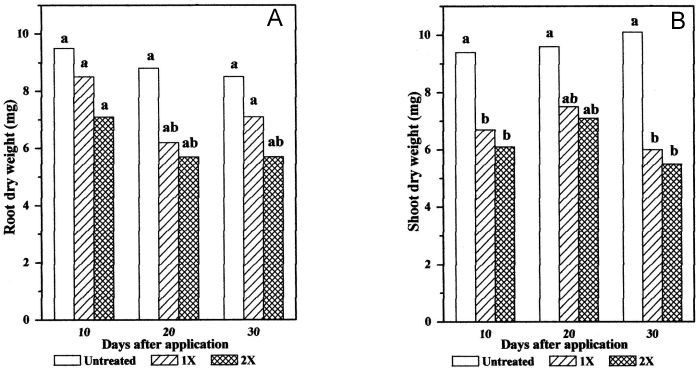

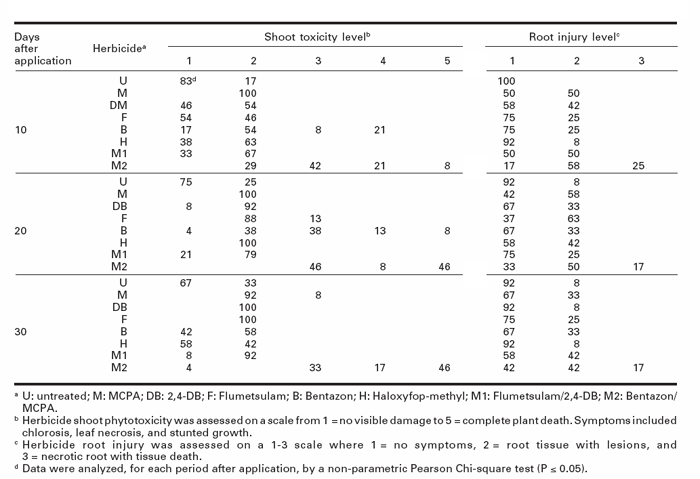
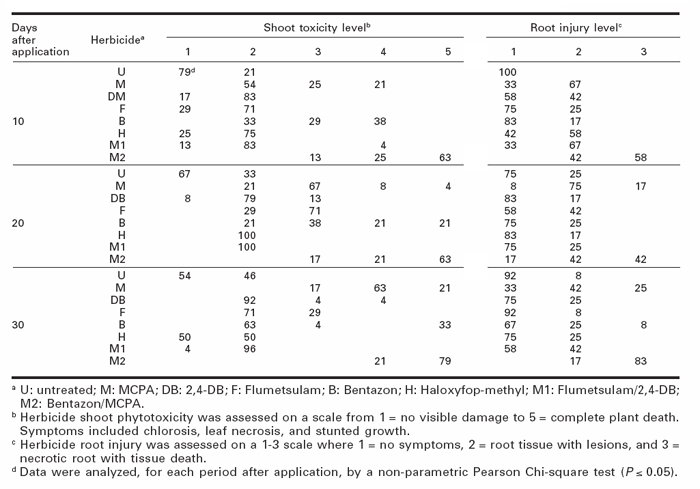
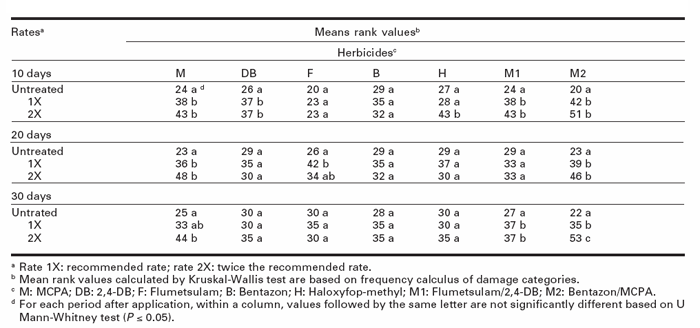
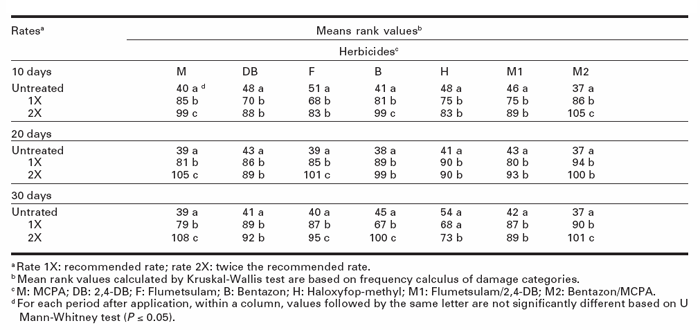
 10.7202/706058ar
10.7202/706058ar